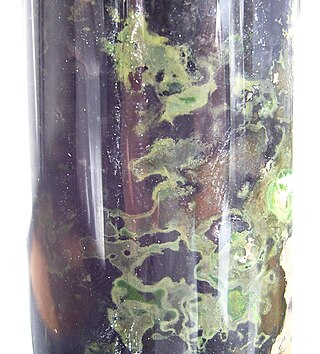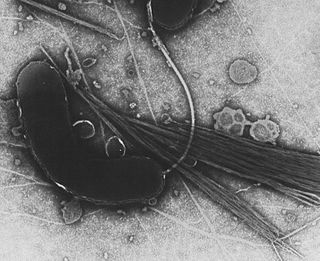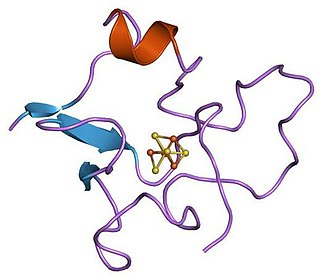
Sulfur (also spelled sulphur in British English) is a chemical element; it has symbol S and atomic number 16. It is abundant, multivalent and nonmetallic. Under normal conditions, sulfur atoms form cyclic octatomic molecules with the chemical formula S8. Elemental sulfur is a bright yellow, crystalline solid at room temperature.

The green sulfur bacteria are a phylum, Chlorobiota, of obligately anaerobic photoautotrophic bacteria that metabolize sulfur.

In biochemistry, chemosynthesis is the biological conversion of one or more carbon-containing molecules and nutrients into organic matter using the oxidation of inorganic compounds or ferrous ions as a source of energy, rather than sunlight, as in photosynthesis. Chemoautotrophs, organisms that obtain carbon from carbon dioxide through chemosynthesis, are phylogenetically diverse. Groups that include conspicuous or biogeochemically important taxa include the sulfur-oxidizing Gammaproteobacteria, the Campylobacterota, the Aquificota, the methanogenic archaea, and the neutrophilic iron-oxidizing bacteria.
The purple sulfur bacteria (PSB) are part of a group of Pseudomonadota capable of photosynthesis, collectively referred to as purple bacteria. They are anaerobic or microaerophilic, and are often found in stratified water environments including hot springs, stagnant water bodies, as well as microbial mats in intertidal zones. Unlike plants, algae, and cyanobacteria, purple sulfur bacteria do not use water as their reducing agent, and therefore do not produce oxygen. Instead, they can use sulfur in the form of sulfide, or thiosulfate (as well, some species can use H2, Fe2+, or NO2−) as the electron donor in their photosynthetic pathways. The sulfur is oxidized to produce granules of elemental sulfur. This, in turn, may be oxidized to form sulfuric acid.

Purple bacteria or purple photosynthetic bacteria are Gram-negative proteobacteria that are phototrophic, capable of producing their own food via photosynthesis. They are pigmented with bacteriochlorophyll a or b, together with various carotenoids, which give them colours ranging between purple, red, brown, and orange. They may be divided into two groups – purple sulfur bacteria and purple non-sulfur bacteria. Purple bacteria are anoxygenic phototrophs widely spread in nature, but especially in aquatic environments, where there are anoxic conditions that favor the synthesis of their pigments.

The Chromatiaceae are one of the two families of purple sulfur bacteria, together with the Ectothiorhodospiraceae. They belong to the order Chromatiales of the class Gammaproteobacteria, which is composed by unicellular Gram-negative organisms. Most of the species are photolithoautotrophs and conduct an anoxygenic photosynthesis, but there are also representatives capable of growing under dark and/or microaerobic conditions as either chemolithoautotrophs or chemoorganoheterotrophs.
The Ectothiorhodospiraceae are a family of purple sulfur bacteria, distinguished by producing sulfur globules outside of their cells. The cells are rod-shaped, vibrioid, or spirilla, and they are able to move using flagella. In general, they are marine and prefer anaerobic conditions. Ectothiorhodospiraceae are a vibrio bacteria that require salty living conditions to survive and grow: classifying them as slightly halophilic. Like all purple sulfur bacteria, they are capable of photosynthesis. To complete this energy process, Sulfur compounds are used as electron donors for carbon fixation in the pentose phosphate pathway. This elemental sulfur accumulates outside of the cells.

Phototrophs are organisms that carry out photon capture to produce complex organic compounds and acquire energy. They use the energy from light to carry out various cellular metabolic processes. It is a common misconception that phototrophs are obligatorily photosynthetic. Many, but not all, phototrophs often photosynthesize: they anabolically convert carbon dioxide into organic material to be utilized structurally, functionally, or as a source for later catabolic processes. All phototrophs either use electron transport chains or direct proton pumping to establish an electrochemical gradient which is utilized by ATP synthase, to provide the molecular energy currency for the cell. Phototrophs can be either autotrophs or heterotrophs. If their electron and hydrogen donors are inorganic compounds they can be also called lithotrophs, and so, some photoautotrophs are also called photolithoautotrophs. Examples of phototroph organisms are Rhodobacter capsulatus, Chromatium, and Chlorobium.

Sulfate-reducing microorganisms (SRM) or sulfate-reducing prokaryotes (SRP) are a group composed of sulfate-reducing bacteria (SRB) and sulfate-reducing archaea (SRA), both of which can perform anaerobic respiration utilizing sulfate (SO2−
4) as terminal electron acceptor, reducing it to hydrogen sulfide (H2S). Therefore, these sulfidogenic microorganisms "breathe" sulfate rather than molecular oxygen (O2), which is the terminal electron acceptor reduced to water (H2O) in aerobic respiration.

The Winogradsky column is a simple device for culturing a large diversity of microorganisms. Invented in the 1880s by Sergei Winogradsky, the device is a column of pond mud and water mixed with a carbon source such as newspaper, blackened marshmallows or egg-shells, and a sulfur source such as gypsum or egg yolk. Incubating the column in sunlight for months results in an aerobic/anaerobic gradient as well as a sulfide gradient. These two gradients promote the growth of different microorganisms such as Clostridium, Desulfovibrio, Chlorobium, Chromatium, Rhodomicrobium, and Beggiatoa, as well as many other species of bacteria, cyanobacteria, and algae.
Microbial metabolism is the means by which a microbe obtains the energy and nutrients it needs to live and reproduce. Microbes use many different types of metabolic strategies and species can often be differentiated from each other based on metabolic characteristics. The specific metabolic properties of a microbe are the major factors in determining that microbe's ecological niche, and often allow for that microbe to be useful in industrial processes or responsible for biogeochemical cycles.

Gammaproteobacteria is a class of bacteria in the phylum Pseudomonadota. It contains about 250 genera, which makes it the most genus-rich taxon of the Prokaryotes. Several medically, ecologically, and scientifically important groups of bacteria belong to this class. All members of this class are Gram-negative. It is the most phylogenetically and physiologically diverse class of the Pseudomonadota.
Chromatium okenii is a Gram-negative bacterium found in water. It belongs to the Purple sulfur bacteria. These bacteria are capable of photosynthesis and use Hydrogen sulfide (H2S) as an electron donor for CO2 reduction and so do not produce oxygen. This type of photosynthesis is called anoxygenic photosynthesis. Chromatium okenii is anaerobic and the cells are slightly curved or straight rods.

High potential iron-sulfur proteins (HIPIP) are a class of iron-sulfur proteins. They are ferredoxins that participate in electron transfer in photosynthetic bacteria as well as in Paracoccus denitrificans.
Vampirococcus is an informally described genus of ovoid Gram-negative bacteria, but the exact phylogeny remains to be determined. This predatory prokaryote was first described in 1983 by Esteve et al. as small, anaerobic microbe about 0.6 μm wide before being given the name of Vampirococcus in 1986 by Guerrero et al. This prokaryote is a freshwater obligate predator that preys specifically on various species of the photosynthetic purple sulfur bacterium, Chromatium. As an epibiont, Vampirococcus attaches to the cell surface of their prey and "sucks" out the cytoplasm using a specialized cytoplasmic bridge. They are commonly mentioned as an example of epibionts when discussing strategies employed by bacterial predators. This microbe still has yet to be classified based on genomic sequencing or 16S rRNA because it cannot be sustained long enough outside its natural environment to isolate a pure culture.

Flavocytochrome c sulfide dehydrogenase, also known as Sulfide-cytochrome-c reductase (flavocytochrome c) (EC 1.8.2.3), is an enzyme with systematic name hydrogen-sulfide:flavocytochrome c oxidoreductase. It is found in sulfur-oxidising bacteria such as the purple phototrophic bacteria Allochromatium vinosum. This enzyme catalyses the following chemical reaction:
The Sippewissett microbial mat is a microbial mat in the Sippewissett Salt Marsh located along the lower eastern Buzzards Bay shoreline of Cape Cod, about 5 miles north of Woods Hole and 1 mile southwest of West Falmouth, Massachusetts, in the United States. The marsh has two regions, the Great Sippewisset Marsh to the north and Little Sippewisset Marsh to the south, separated from each other by a narrow tongue of land. The marsh extends into an estuary in which the intertidal zone provides a dynamic environment that supports a diverse ecology, including threatened and endangered species such as the roseate tern. The ecology of the salt marsh is based in and supported by the microbial mats which cover the ground of the marsh.
Marichromatium is a genus in the phylum Pseudomonadota (Bacteria). The name Marichromatium derives from: Latin mare, the sea; Neo-Latin Chromatium, a genus name; to give Marichromatium, the Chromatium of the sea, the truly marine Chromatium.

Microbial oxidation of sulfur is the oxidation of sulfur by microorganisms to build their structural components. The oxidation of inorganic compounds is the strategy primarily used by chemolithotrophic microorganisms to obtain energy to survive, grow and reproduce. Some inorganic forms of reduced sulfur, mainly sulfide (H2S/HS−) and elemental sulfur (S0), can be oxidized by chemolithotrophic sulfur-oxidizing prokaryotes, usually coupled to the reduction of oxygen (O2) or nitrate (NO3−). Anaerobic sulfur oxidizers include photolithoautotrophs that obtain their energy from sunlight, hydrogen from sulfide, and carbon from carbon dioxide (CO2).
Dissimilatory sulfite reductase is an enzyme that participates in sulfur metabolism in dissimilatory sulfate reduction.












